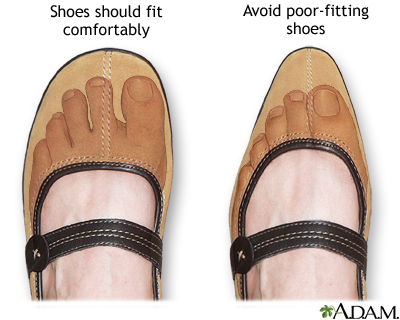Pain or discomfort can be felt anywhere in the foot. You may have pain in the heel, toes, arch, instep, or the bottom of the foot (sole).
Causes
Foot pain may be due to:
- Aging
- Being on your feet for long periods of time
- Being overweight
- A foot deformity that you were born with or develops later
- Injury
- Shoes that fit poorly or do not have much cushioning
- Too much walking or other sports activity
- Trauma
The following can cause foot pain:
- Arthritis and gout -- Common in the big toe, which becomes red, swollen, and very tender.
- Broken bones.
- Bunions -- A bump at the base of the big toe from wearing narrow-toed shoes or from abnormal bone alignment.
- Calluses and corns -- Thickened skin from rubbing or pressure. Calluses are on the balls of the feet or heels. Corns appear on the top of your toes.
- Hammer toes -- Toes that curl downward into a claw-like position.
- Fallen arches -- Also called flat feet.
- Morton neuroma -- A thickening of nerve tissue between the toes.
- Nerve damage from diabetes.
- Plantar fasciitis.
- Plantar warts -- Sores on the soles of your feet due to pressure.
- Sprains.
- Stress fracture.
- Nerve problems.
- Heel spurs or Achilles tendinitis.
- Tendon or ligament tears
Home Care
The following steps may help relieve your foot pain:
- Apply ice to reduce pain and swelling.
- Keep your painful foot elevated as much as possible.
- Reduce your activity until you feel better.
- Wear shoes that fit your feet and are right for the activity you are doing.
- Wear foot pads to prevent rubbing and irritation.
- Use an over-the-counter pain medicine, such as ibuprofen or acetaminophen. (Talk to your health care provider first if you have a history of ulcer or liver problems.)
Other home care steps depend on what is causing your foot pain.
The following steps can prevent foot problems and foot pain:
- Wear comfortable, properly fitting and supportive shoes, with good arch support and cushioning.
- Wear shoes with plenty of room around the ball of your foot and toes and a wide toe box.
- Avoid narrow-toed shoes and high heels.
- Wear sneakers as often as possible, especially when walking.
- Replace running shoes frequently.
- Warm up and cool down when exercising. Always stretch first.
- Stretch your Achilles tendon. A tight Achilles tendon can lead to poor foot mechanics.
- Increase your amount of exercise slowly over time to avoid putting excessive strain on your feet.
- Stretch the plantar fascia or the bottom of your feet.
- Lose weight if you need to.
- Learn exercises to strengthen your feet and avoid pain. This can help flat feet and other potential foot problems.

When to Contact a Medical Professional
Contact your provider if:
- You have sudden, severe foot pain.
- Your foot pain began following an injury, especially if your foot is bleeding or bruising, or you cannot put weight on it.
- You have redness or swelling of the joint, an open sore or ulcer on your foot, or a fever.
- You have pain in your foot and have diabetes or a disease that affects blood flow.
- Your foot does not feel better after using at-home treatments for 1 to 2 weeks.
What to Expect at Your Office Visit
Your provider will do a physical exam. Your provider will ask questions about your symptoms and medical history.
X-rays or MRI may be done to help your provider diagnose the cause of your foot pain.
Treatment depends on the exact cause of the foot pain. Treatment may include:
- A splint or a cast, if you broke a bone
- Shoes that protect your feet
- Removal of plantar warts, corns, or calluses by a foot specialist
- Orthotics, or shoe inserts
- Physical therapy to relieve tight or overused muscles
- Foot surgery
Alternative Names
Pain - foot
References
Chiodo CP, Price MD, Sangeorzan AP. Foot and ankle pain. In: Firestein GS, Budd RC, Gabriel SE, Koretzky GA, McInnes IB, O'Dell JR, eds. Firestein & Kelley's Textbook of Rheumatology. 11th ed. Philadelphia, PA: Elsevier; 2021:chap 52.
Grear BJ. Disorders of tendons and fascia and adolescent and adult pes planus. In: Azar FM, Beaty JH, eds. Campbell's Operative Orthopaedics. 14th ed. Philadelphia, PA: Elsevier; 2021:chap 83.
Hickey B, Mason L, Perera A. Forefoot problems in sport. In: Miller MD, Thompson SR, eds. DeLee, Drez, & Miller's Orthopaedic Sports Medicine. 5th ed. Philadelphia, PA: Elsevier; 2020:chap 121.
Kadakia AR, Aiyer AA. Heel pain and plantar fasciitis: hindfoot conditions. In: Miller MD, Thompson SR, eds. DeLee, Drez, & Miller's Orthopaedic Sports Medicine. 5th ed. Philadelphia, PA: Elsevier; 2020:chap 120.
Rothenberg P, Swanton E, Molloy A, Aiyer AA, Kaplan JR. Ligamentous injuries of the foot and ankle. In: Miller MD, Thompson SR, eds. DeLee, Drez, & Miller's Orthopaedic Sports Medicine. 5th ed. Philadelphia, PA: Elsevier; 2020:chap 117.
Review Date 6/17/2024
Updated by: C. Benjamin Ma, MD, Professor, Chief, Sports Medicine and Shoulder Service, UCSF Department of Orthopaedic Surgery, San Francisco, CA. Also reviewed by David C. Dugdale, MD, Medical Director, Brenda Conaway, Editorial Director, and the A.D.A.M. Editorial team.








